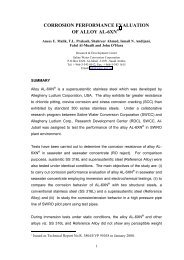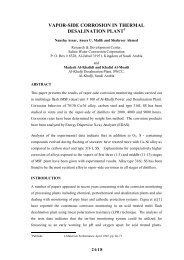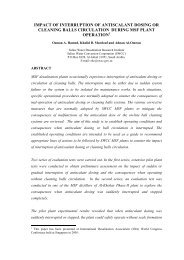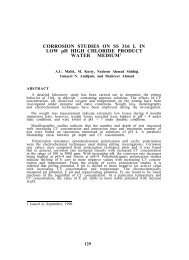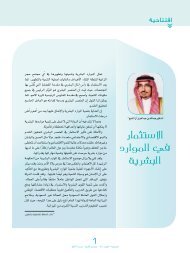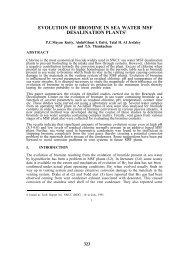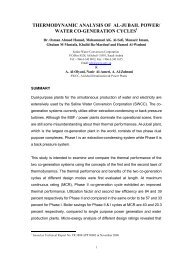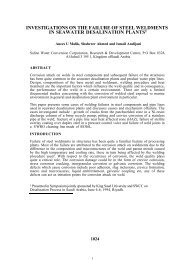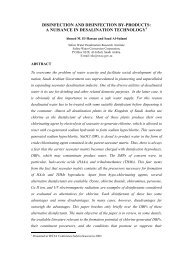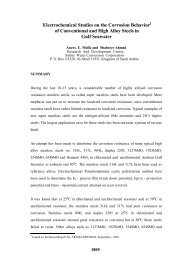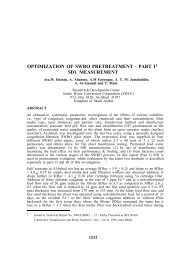CORROSION MONITORING OF SWCC PLANTS - I:1 Vapor-Side ...
CORROSION MONITORING OF SWCC PLANTS - I:1 Vapor-Side ...
CORROSION MONITORING OF SWCC PLANTS - I:1 Vapor-Side ...
Create successful ePaper yourself
Turn your PDF publications into a flip-book with our unique Google optimized e-Paper software.
This provides a plausible explanation for the significantly higher corrosion rates of<br />
cupronickel alloy in vent line. The corrosion products from carbon steel specimens<br />
exposed to non-condensable gases in flash chambers invariably contain sulfur though in<br />
small concentrations. The vent line corrosion products contain no or insignificantly low<br />
concentration of sulfur. Copper is present in small but in perceptible concentrations in<br />
corrosion products of steel exposed in vent lines. There is no plausible explanation for<br />
the existence of copper in the scales or corrosion products of the carbon steel coupons.<br />
A detailed systematic study in collaboration with chemistry and Biology Departments<br />
shall be useful in investigating the source of sulfur in the non-condensable gases. The<br />
EDAX data also indicate the presence of significant concentration of bromide in the<br />
corrosion products. The source of bromide could be the seawater.<br />
Considering the corrosion behavior of materials in vent line and evaporator at different<br />
stages, the shape of the weight loss vs. no stages of curves can be explained broadly as<br />
follows:<br />
(i)<br />
(ii)<br />
Steep increase in weight loss (or corrosion rates) is due to breaking up or<br />
spalling of scales when fresh alloy surface comes into contact with gases.<br />
Decrease in weight loss could be due to progressive formation of adherent<br />
protective scales.<br />
(iii) Presence of plateau (no change in weight) could be due to the formation of<br />
protective scales.<br />
An analysis of the corrosion rates data (by weight loss technique) from corrosion<br />
monitoring studies in flashing brine in the evaporator and water boxes provide some<br />
useful information regarding the corrosion of carbon steel and cupronickel alloys.<br />
Whilst the corrosion rate of carbon steel varies from 0.6 MPY (stage # 6) to 1.8 (stage #<br />
19) after 25000 hours, the corrosion rates of cupronickel (70-30) in water boxes are 0.18<br />
(# 7-8, unit 100) and 0.13 (# 5-6, unit 200) after the same exposure time. The low<br />
corrosion rate values for both carbon steel and cupronickel (70-30) alloys are well<br />
within the allowable range. Comparing these values with those for vapor phase<br />
corrosion in evaporator (9000 hrs exposures) and vent line (2000 and 4000 hrs<br />
exposures), corrosion rates are of the same magnitude.<br />
1632



